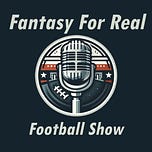The amount of writing here probably suggests that more has changed than it has, but I wanted to update my rankings officially now that we are in May, and reflect on the (very few) minor changes that have been made. This is also the first ranking where I have a better sense of the market and ADP, which allows me to more firmly know where the controversies will arise.
Updated Rookie Draft Rankings (May 2025)
TIER 1A
Ashton Jeanty, RB, Las Vegas Raiders
TIER 1B
Tetairoa McMillan, WR, Carolina Panthers
Omarion Hampton, RB, Los Angeles Chargers
While WRs in the First Round bust far more frequently than RBs, receiving Top 10 Draft Capital at the WR position still strongly aligns with a high likelihood of success and an extremely high Hit%. Everything about McMillan, in my eyes, aligns with a player with a high likelihood of success, from the Draft Capital to the athleticism/size to the production. There also seems to be some apprehension about the landing spot, but as my Dynasty QB13, I’m a big fan of Bryce Young and the upside this marriage provides. All of this rounds out to Tetairoa McMillan having an excellent blend of floor & ceiling, and as the prospect I clearly preferred on talent entering the NFL Draft, McMillan ends up above Hampton in my final rankings.
Hampton’s excellent landing spot helps to affirm that he is the clear RB2, but grouping Hampton’s Draft Capital together with Ashton Jeanty’s as “first round” seems erroneous; the investment in Hampton is far closer to the investment in Quinshon Judkins and TreVeyon Henderson than it is to Ashton Jeanty. And from an outcomes perspective, anecdotally we have had busts in the late 1st Round (CEH, Penny, Michel) as well as a high frequency of hits within the first 10 picks of Round 2 (Full List Picks 33-42: Hall, KW3, Javonte, Swift, Taylor, Chubb, RoJo, and D Cook). Considering that those early 2nd round players possess high upside outcomes even with very few busts, for as much as Hampton is the consensus 1.02, there is a strong Draft Capital related argument that he should be tiered with Judkins and Henderson. The gap between late-1st and early-2nd is significantly overrated.
TIER 1C
Quinshon Judkins, RB, Cleveland Browns
Cam Ward, QB, Tennessee Titans
Travis Hunter, WR/CB, Jacksonville Jaguars
TreVeyon Henderson, RB, New England Patriots
Most importantly within this tier, remember that a Big Board is not a projection of ADP. With only one highly-drafted, highly-graded QB, in Superflex Rookie Drafts, Cam Ward will almost always go more highly than the 1.05. A Big Board should also be applied to individual circumstances. If you are a team that is in need of a QB, then it makes perfect sense to not only jump Quinshon Judkins, but move up an entire half tier at least to draft Cam Ward. In general, while very highly drafted QBs mitigate the general risk at the position, QB is still a risky development position compared to RB in particular, and there are elements of Ward’s game that could suggest a particularly high-risk profile.
Aside from the excellent QB, Quinshon Judkins’ situation is far more similar to Omarion Hampton’s than their market gap suggests. Both of these players have the potential to become the identity of their football teams. That lack of excellent QB is a significant knock against Judkins, but he has every opportunity to become the identity of an offense for the next several years, and there are very few RBs around the NFL who are in position to be an identity for their offense AND have the requisite size and physical attributes to turn that into high-end fantasy success. My Big Board tries to take into account how the prospect would rank compared to other prospects at their position regardless of Draft Class as well as an estimation of career fantasy value. When it comes to the latter figure, while Cam Ward has a far greater chance of some day become a 1st Round SF Fantasy Pick, Quinshon Judkins has a far greater-than-average ability to be a higher-tier prospect in my eyes, and this high-floor + high-ceiling mold puts Judkins as my 1.04.
There is almost nothing unique or insightful that can be said about Travis Hunter. He himself is too unique to have historical comparisons, which are the basis for almost all analysis. The statistical concern with Hunter is that a reduced Snap% on Offense could lower his volume, and ultimately volume is far more important than effectiveness in Fantasy Football.
TreVeyon Henderson feels like the best value in this tier, but ultimately that just means that the tier is working as it should: #7 should be the best value regardless of who gets here. While the allure of a Gibbs-ian role for Henderson is appealing, there is at least some doubt that his value could also be reduced by being limited to gadget and big-play explosives instead of consistent volume. This is not a very significant doubt, which is why Henderson is a perfectly reasonable pick on my board as soon as 1.04. In fact, Henderson’s ball security and pass protection are underestimated reasons why he could be, alongside Ashton Jeanty, the first player in this class to likely make a fantasy impact.
TIER 2A
Emeka Egbuka, WR, Tampa Bay Buccaneers
Matthew Golden, WR, Green Bay Packers
Kaleb Johnson, RB, Pittsburgh Steelers
R.J. Harvey, RB, Denver Broncos
TIER 2B – Higher in TEP
Colston Loveland, TE, Chicago Bears
Tyler Warren, TE, Indianapolis Colts
R.J. Harvey and Kaleb Johnson received solid draft capital and excellent landing spots, but Emeka Egbuka and Matthew Golden’s combination of Draft Capital – even adjusted by position – and pre-draft grade give them just the slightest edge in this tier. Importantly though, Harvey and Johnson are far more likely to provide some level of value for fantasy teams. Harvey and Johnson both seem to be going to teams likely to utilize them in a featured role in the 2025 season, and if you are drafting for floor or even to get a more sure-fire competitive piece for the 2025 season, I would lean towards the RBs. It is not just Harvey’s age that puts him at #11, but the general idea that Kaleb Johnson was a significantly higher graded RB on my board pre-draft. While Harvey does possess that instant appeal, Johnson also could be a high-volume workload back in year 1. That higher volume size of Johnson is his second major appeal compared to Harvey. So while Harvey does have situation and draft capital on his side, the objective advantages of size for volume and age give a slight edge to Johnson. The tangible benefit of that age will come if either RB has a hiccup within the first few years; a hiccup for Johnson could still lead to a situation where he gets a second soft landing spot. While it is hard to imagine too much now, Harvey’s market value will decline swiftly within his rookie contract compared to most RBs here, at least adjusted by their performances.
While I do prefer Golden’s landing spot, Egbuka was also the higher graded WR on my rankings pre-draft as well as the higher drafted WR. Even with some questions playing alongside Evans and Godwin and J McMillan, I’m going to lean on a Talent > Situation evaluation and favor Emeka Egbuka. Some seem to dismiss Golden’s situation, but at this point the Packers WR room seems wildly overrated. Christian Watson tore his ACL in Week 18 and should not be mentioned in regard to Matthew Golden; if Golden cannot make his impact before Watson is back at 100%, then the chances that Golden has a successful career will already be significantly reduced. Likewise, Dontayvion Wicks had some hype going into 2024, including as a sleeper listed by this show in Dynasty, but the residual effects from that sleeper-arch are unwarranted. Wicks may improve, but 2024 did not indicate that Wicks was someone to worry about. At that point, you have Romeo Doubs and Jayden Reed. While Doubs and Reed are not anything to sneeze at necessarily, they are not the kind of depth that should scare anyone away.
Colston Loveland and Tyler Warren are both excellent TE prospects, but neither is a Brock Bowers-level prospect. With that in mind, the TE position outside of TEP leagues still requires elite performance to create a hit. This far more difficult target is why I generally will pass on TEs until the first run of major players is off the board. For myself, in non-TEP, there are 11 players I will select before considering a TE unless my need is absolutely dire, which seems unlikely given the affordability of TEs ranked 8-12. The TEs in these rankings being grouped into 2-3 simple tiers is not intentional, but is a convenient coincidence to bump these TEs up into Tier 2A in 0.5 TEP and probably into 1C in 1 TEP, though they may still be the bottom of that tier in 1 TEP on my board.
TIER 3A
Luther Burden III, WR, Chicago Bears
Jaxson Dart, QB, New York Giants
TIER 3B
Jayden Higgins, WR, Houston Texans
Jack Bech, WR, Las Vegas Raiders
Tyler Shough, QB, New Orleans Saints
Kyle Williams, WR, New England Patriots
Tre Harris, WR, Los Angeles Chargers
Jaylin Noel, WR, Houston Texans
While Jaxson Dart did receive “first round” Draft Capital, being drafted in the “first round” is very often misleading when not applied to highly-drafted QBs. In the last ten years, 80% of QBs selected in the “first round” have been selected in the top 12 picks. Including the 2025 Draft, there have also been more QBs selected 1st Overall (8) than between picks 13-32 (7) in this time frame. Not only does this mean that late first round QBs represent a very small percentage of the players we associate with “First Round” Draft Capital, but within that small sample, there are reasons to be discouraged about the likelihood for success. Within the six QBs who have played an NFL Season, 50% (Haskins, Pickett, Lynch) failed to produce a top 24 season. Mac Jones is among the hits, and Jones both never finished above QB22 and had his fantasy value crater within 4 weeks of his second NFL season. Jordan Love is a legitimate hit, though there are some practical asterisks with fantasy football; Love was available for a 2nd Round Rookie pick for about 2-3 years, and in fact in his 3rd Season, the value cratered to closer to a 4th Round Rookie pick. Lamar Jackson with just one missing season at the top is the only player drafted between picks 13-32 to play two full seasons under his rookie contract.
None of this is to say that you should exclusively pass on Dart, and there is clear positional value in getting QBs, but there is a misconception on the market about what this Draft Capital means. Yes, the above exercise is based on a small sample, but going back to the original point, the sheer fact that it is a small sample – that so few QBs go in this range – suggests it is not necessarily rarified air. In particular, if you have a grade on Dart that is much higher than my grade, it makes perfect sense to target Jaxson Dart in drafts. But my grade aligns with the NFL Grade, and the NFL Grade from my perspective of history suggests about the exact same as what a second round pick suggests. Jordan Love right now is separating the late-1st and the top 2 rounds in recent memory, but Jalen Hurts finding success from pick 53 with so few QBs being drafted in the 2nd Round certainly suggests that the gap between late-1st and 2nd Round could at least be considered marginal at best when it comes to projecting success. And the high rate of busts compared to the top-12 picks suggests a low likelihood of that success. In general, the first round capital does almost guarantee an opportunity to start, but that has largely been true about the entire 2nd Round and Tyler Shough’s 40th Overall Draft Capital as well. Aside from Kyle Trask, who was the very last pick of the 2nd round (64th Overall), you have to go back to Christian Hackenberg to find a 2nd Round pick that didn’t start at least 15 Games for his franchise. Lock, Levis, and even Kizer got a significant run of 12-15 Games in a season.
This is why Shough is so much more highly ranked in my own rankings. While my pre-draft prior on Shough was not particularly high, there is a clear misconception about the gap in draft capital between Ward, Dart, Shough, and Milroe. To use an NFL Draft Trade Chart (not for fantasy, for NFL Teams), the values of the 1st, 25th, 40th, and 92nd picks are respectively 3000, 720, 500, and 132. While there is a somewhat significant gap between Dart and Shough, they are considerably closer than any other pair of QBs particularly by relative difference. Shough’s draft capital difference with Milroe may not be that much different than his gap with Dart in terms of the sum, but the Saints spent over 3x the amount of Draft Capital on Shough compared to the Seahawks investment in Jalen Milroe. This higher likelihood to get 12-15 GS at the NFL level propel Shough higher up in my rankings in a class that has very few profiles that I am ranking confidently.
Luther Burden III did not get first round draft capital, but his explosive early production and physical tools still suggest he should be apart from the rest of the non-Day 1 WRs when it comes to having just a bit higher likelihood of long-term upside. The Bears also have significantly high investments in their pass catching room, but the lack of proven production to date likely indicates that Luther Burden’s path to success is more open than it may initially appear. Jack Bech is my favorite landing spot, but Jayden Higgins’ draft capital at the very top of the 2nd round is a bit of a tier separator for two players who had somewhat similar grades. And while I was rising on Bech late in the process, Higgins was the only WR other than Burden separated from this bunch consistently pre-draft. Higgins and Jaylin Noel will likely not both find success, but there’s certainly enough opportunity to consider it a good landing spot for both of them. Aside from the situation mentioned above, Bech is an excellent possession WR, though it is interesting to think about how the combination of Bech, Meyers, and Brock Bowers will be deployed. Kyle Williams was the latest riser in my rankings, and ultimately goes to what might be the best landing spot for high ceiling potential volume. As a player with some YAC juice, Williams may also be featured as a player that can get simple and easy passes from Drake Maye.
TIER 4A
Cam Skattebo, RB, New York Giants
Jalen Milroe, QB, Seattle Seahawks
Shedeur Sanders, QB, Cleveland Browns
TIER 4B – Higher in TEP
Harold Fannin Jr., TE, Cleveland Browns
Terrance Ferguson, TE, Los Angeles Rams
Mason Taylor, TE, New York Jets
Elijah Arroyo, TE, Seattle Seahawks
TIER 4C
Pat Bryant, WR, Denver Broncos
Tai Felton, WR, Minnesota Vikings
Bhayshul Tuten, RB, Jacksonville Jaguars
TIER 4D
Dillon Gabriel, QB, Cleveland Browns
Will Howard, QB, Pittsburgh Steelers
It is important to remember that, particularly in the late rounds, our goals can diverge from the NFL. We are not looking for players who can contribute to an NFL franchise. For us in fantasy, the gap between WR50 and WR100 is nearly irrelevant. We are looking for the players who are most likely to be fantasy relevant at their positions.
My conviction after pick 21 reduces greatly.
Cam Skattebo is in an excellent position to be a lead back, though Tyrone Tracy was solid in 2024 and the early-4th capital does not necessarily suggest that Skattebo would be likely to become the lead RB. Jalen Milroe has the highest fantasy upside of any player in the 2025 Rookie Draft, but it is extremely unlikely that he reaches that upside. He may be a player to look to sell if hype ever builds. Shedeur Sanders falls in line with the first objective here; Dillon Gabriel is more likely to be a contributor to an NFL Franchise, but Sanders is still the player I would consider more likely to be a potential top-24 NFL QB. Will Howard is another QB ranked fairly highly due to proximity. Even if Rodgers or Cousins signs with the Pittsburgh Steelers, the path for Howard is still very clear, and he does have some intriguing fantasy skills with his size and mobility.
All four TEs available in this tier have a combination of intriguing draft capital and some pass catching history. There would normally not be so many TEs ranked so highly, but given these profiles relative to the TEs that go in Round 3 most years, it makes perfect sense to list all of these TEs with Round 3 grades. In many leagues and league settings, I may push the TEs up or down my rankings. TEP is obvious, but in non-TEP there are many league settings where I may be more exclusively focused on positions like RB or WR in this range.
Pat Bryant is one of my biggest true risers. While I still am lukewarm on the prospect in general, the capital and landing spot are both intriguing. Tai Felton yo-yo’d too much between my last two rankings, but now I feel he is in a proper spot. Bhayshul Tuten is another player who has raised up my rankings a bit. While I am still not ranking him high enough to likely get him in any leagues, he was a very-very early 4th Round pick, and he is the first RB pick of a new regime with an expiring player.
TIER 5
Elic Ayomanor, WR, Tennessee Titans
Jordan James, RB, San Francisco 49ers
Dylan Sampson, RB, Cleveland Browns
Trevor Etienne, RB, Carolina Panthers
Savion Williams, WR, Green Bay Packers
Woody Marks, RB, Houston Texans
Devin Neal, RB, New Orleans Saints
D.J. Giddens, RB, Indianapolis Colts
Jarquez Hunter, RB, Los Angeles Rams
Phil Mafah, RB, Dallas Cowboys
Tory Horton, WR, Seattle Seahawks
Jaydon Blue, RB, Dallas Cowboys
Jalen Royals, WR, Kansas City Chiefs
Isaac Teslaa, WR, Detroit Lions
Mitchell Evans, TE, Carolina Panthers
Gunnar Helm, TE, Tennessee Titans
Tommy Mellott, WR, Las Vegas Raiders
There is not much to add here. I could discuss each player, but most of the relevant players here 1) have Deeper Dives and 2) are extremely unlikely to be relevant at any point for fantasy. Tune into the most recent episode of the Fantasy for Real podcast where I walk through each and every Day 3 pick of the 2025 Class if you are looking for more in-depth takeaways for each Day 3 situation.
The only player I did want to mention is Jaydon Blue. Blue is very young, explosive, and intriguing. That said, when I am trying to forecast a player to take over in a shallow depth chart, I am looking for a player who is more likely to take on the workload. We have had some smaller RBs take on heavy workloads recently, but they were all workload RBs in College who were mostly healthy through that experience. Blue has never been a heavy workload RB, and he has dealt with injuries that have restricted his ability to try. Blue may take advantage of an open room and have some success, but I would never forecast him to have the type of volume we were envisioning from even a Day 3 Cowboys RB. On the other hand, while he was drafted far later and is far more likely to get cut, Mafah is the Cowboys RB who is far more likely to have his “Rico Dowdle run.” Highlighting one fade in a Day 3 class is smart bet (all players in this range are likely to fail) which could ultimately be a big mistake, but Blue is a major market fade as I see him as one one of the more locked in 3rd Round picks and even early-3rd Round picks in ADP.
//
Draft Capital
Rounds and Days are convenient ways to separate the draft, but I have not found them to ultimately be the most beneficial. While I do usually go by draft pick ranges, I like to use an NFL Pick Trade Chart to try and estimate what teams spent on players. To be clear, I am talking about something unrelated to Fantasy Football, and more like the Jimmy Johnson or other charts that teams use when establishing how much they are overpaying or underpaying in a trade. I believe this can help visualize the difference of picks in certain ranges.
If I were more savvy, I would make this into a color coded graph adjusted by position – and maybe I will eventually – but for now, here is a list of values for the QBs, RBs, and WRs in the 2025 Class.
https://docs.google.com/spreadsheets/d/1unCKLlt_I3ZdHO5v-_5yhcmiBkwpi20ba_ClB4PwhgE/edit?usp=sharing
This chart is not perfect, but I do find it does a better job of estimating values directly than “Round X” or “Pick Y.”
//
C.J.












Share this post